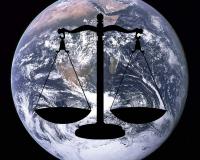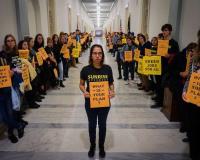
Vibrant Environment
Governance And Rule Of Law
All | Biodiversity | Climate Change and Sustainability | Environmental Justice | Governance and Rule of Law | Land Use and Natural Resources | Oceans and Coasts | Pollution Control

On December 13, 2018, the U.S. Court of Appeals for the Fourth Circuit vacated permits issued by the U.S. Forest Service authorizing a pipeline, known as the Atlantic Coast Pipeline, to be constructed across two national forests and the Appalachian Trail. The Atlantic Coast Pipeline is a proposed 604-mile natural gas pipeline that would stretch from West Virginia to North Carolina.

Months after the devastating Camp, Woolsey, and Hill fires in California, the fallout of the blazes continues to rock the state. In the past month, PG&E, the state’s largest electric utility, transitioned out several top executives, had its credit rating downgraded to junk status, and was mandated to inspect its entire electric grid in a sharply worded court order. Last week, the company announced plans to file for bankruptcy by January 29. Citizens, insurance companies, and the state government are also feeling the heat as expected damage costs rise and climate change intensifies the frequency of wildfires. The strain on California’s public and private institutions foreshadows the difficult decisions to come across the fire-prone American West.

The regulations, guidance documents, and policy memos that implement the Clean Air Act (CAA) have gotten longer and more complicated over the decades. This increased complexity has created greater compliance burdens for the regulated community, and the argument persists that it has stifled economic growth and not produced health benefits that equal or surpass the burdens imposed. Air quality has dramatically improved over the past 40 years, yet many current air quality standards are now at levels approaching the ambient background.

Natural resource mitigation—avoiding impacts to important species and habitat, minimizing impacts, and then providing offsets for remaining, residual impacts—is a valuable tool for developers and agencies to comply with the requirements of the National Environmental Policy Act, a variety of federal statutes that regulate impacts to important wildlife species and habitat, and/or public land management statutes requiring that uses of public lands be balanced with protection and conservation.

There has been a good deal of focus of late on the role of independent oversight in the administration of government operations. Sometimes oversight mechanisms are created in an ad hoc manner in response to particular issues, as with the appointment of an independent counsel. More often it proceeds under the established system of checks built into law to help ensure transparent, effective, and ethical effectuation of government authorities and duties.

On the campaign trail, Brazilian President Jair Bolsonaro promised to eliminate existing protections of the Amazon. Despite some restrictions on his power to fulfill those promises, his administration will have a huge role to play in determining the delicate future of the earth’s largest rainforest, 65% of which is located within Brazil’s borders. Indeed, limiting the ability of agencies to enforce existing laws is more than sufficient to enable the proliferation of illegal logging, farming, and mining in the rainforest.

Welcome to 2019, a year that stands to be both stimulating and challenging, taking into account all that is happening in our sphere. It also promises to be a year that is deeply reflective for ELI, as we celebrate the Institute's 50th anniversary—50 years of building effective governance and rule of law for environmental protection. The idea around which our programing for the year will be organized is "building on the past to secure the future," and, as you can discern from our website, we will have under this broader rubric a monthly theme and focus. January's theme is pollution prevention.

As we get ready to ring in the New Year, the editors of Vibrant Environment thought it might be nice to take a look back at some of the work ELI did in 2018.
While environmental quality over the past 50 years has no doubt improved, the pace of change is leaving in the dust the linear environmental strategies of the past. We’re living in a fascinating moment in time when divergent forces—private environmental governance, law, technologies, and communities—are coming together, allowing us to harness their combined power in a new environmental paradigm. In A New Environmentalism: The Need for a Total Strategy for Environmental Protection, ELI offers a new way to think about the environmental strategies of tomorrow. The article was published in the September issue of ELR’s News & Analysis and was featured at the 2018 ELI-Miriam Hamilton Keare Policy Forum. We look forward to continuing the conversation in 2019.

“Our nation's food security depends on strong agricultural policy that provides stability for America's farmers and ranchers; protects our land and natural resources; develops new trade opportunities while leveling the playing field for our producers; strengthens rural communities; and helps Americans of all stripes access the nutritious foods they need to keep their families healthy. This is America's food policy. This is the Farm Bill.” (The House of Representatives Committee on Agriculture)

Close to 150 activists were arrested during peaceful protests organized by the youth-led organization Sunrise Movement on Monday, December 10. During and after the direct action, in which thousands of activists visited democratic offices demanding support for incoming Rep. Alexandria Ocasio-Cortez’s (D-N.Y.) proposal for a Select Committee on a Green New Deal, 10 additional democratic representatives pledged their support for the proposal. The resolution would create a committee that would have the specific mandate to draft a Green New Deal—the goals of which include 100% renewable energy, upgrading infrastructure, and green technology deployment — that would be ready by 2020. For “green” democrats, this is a difficult proposal to deny, especially given the depth of research on scaling green strategies, as exemplified by ELI Press’ latest release, Legal Pathways to Deep Decarbonization in the United States: Summary and Key Recommendations.